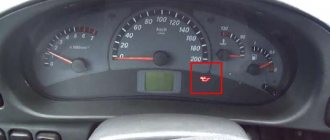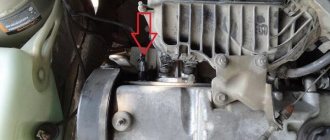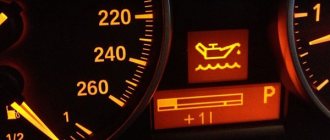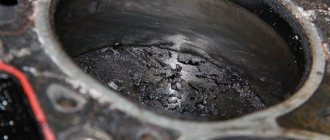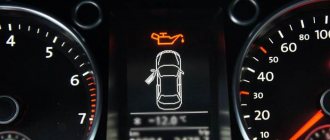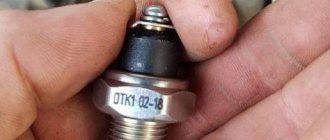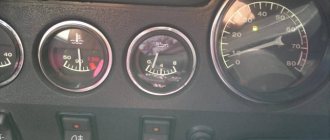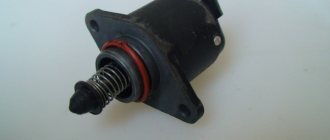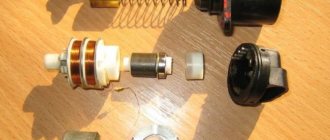There is one of the indicators on the dashboard of cars that informs the driver about a decrease in oil pressure in the engine unit. The so-called oil pressure light in the form of an oil can signals a critical condition of the engine - insufficient amount of lubricant. On the panels of VAZ “classic” cars (six, seven, nine) there is also such an indicator. And if it suddenly lights up while driving or at low speeds while parked, this is a signal that there is a malfunction in the engine.
Reasons for the oil pressure indicator to light up in VAZ cars and their elimination
Before moving on to listing the reasons for turning on an oil lamp, one important note should be made. The disadvantage of the pressure indicator on classic VAZ models is that it lights up not only when there are problems in the engine lubrication system. The car owner can remove and completely overhaul the engine, but the oil pressure light will remain on. The fact is that the sensor itself may be faulty, its wiring may be damaged, and the oil level in the system may drop naturally, simply because the oil has exhausted its service life.
A water pump, also known as a water pump, is responsible for circulating antifreeze in the system. Details of its repair are set out in the following material: https://vazweb.ru/desyatka/ohlazhdenie/remont-pompyi-vaz-2107-svoimi-rukami.html
If there is a malfunction in the lubrication system, the oil pressure indicator on the car dashboard lights up
Oil filter malfunction or poor quality
A failed or malfunctioning oil filter is the most common reason for the indicator to turn on. As a rule, it is because of problems with the filter that the oil indicator lights up at idle and goes out after accelerating .
If the filter fails or its quality leaves much to be desired, then it simply cannot retain the oil, and it begins to flow down into the crankcase. If the oil has leaked out completely, then the next time the engine is started, it will begin to experience so-called oil starvation, which can lead to jamming of its main parts. This is a serious problem that cannot always be eliminated even with expensive repairs.
Oil filter on a VAZ 2106, due to a malfunction in which the oil pressure light comes on
Solution: replace the oil filter. Moreover, when purchasing this part, you should always pay attention to the brand and country of origin. You should also read the vehicle's owner's manual and become familiar with the filter models recommended by the manufacturer. It should be remembered that a high-quality filter cannot be cheap, and saving on this part is categorically unacceptable.
The effect of replacing the oil filter on a VAZ car - video
General decrease in oil level in the system
Sometimes the oil level in the lubrication system of a VAZ car can drop sharply, which will cause the light to turn on. The reason may be a leak of some kind of oil seal, gasket, etc. This phenomenon is especially noticeable when leaving the parking lot, when oil stains remain where the car was parked.
Oil flowing from under the engine cover of the VAZ 2106 helps turn on the low lubricant pressure indicator
Solution: open the hood and carefully inspect the car engine for oil stains. If nothing can be found, the car must be placed on an inspection hole and its underbody and crankcase protection must be inspected (you should use a powerful flashlight for this work). In the vast majority of cases, the leaking connection or gasket can be found. After this, it must be replaced, and oil must be added to the system, bringing the lubrication level to an acceptable level.
The oil pressure sensor is faulty
The oil pressure sensor, like any other car part, can break down over time. After this, it begins to give incorrect readings, misleading the driver.
A faulty oil sensor for a VAZ 2106 car can cause the lubricant pressure indicator to trigger
Solution: check the sensor and replace it. To understand that it is the oil pressure sensor that is faulty, it should be replaced with another sensor that is definitely working (if the repair is carried out in a garage, then a working sensor can be temporarily borrowed from a neighbor who has a similar car). Having installed a working sensor, you need to start the engine. If the light does not light up after starting the engine, then the cause of the problem can be considered established. After this, the car owner can only purchase a new sensor and install it on the car (since this part is practically irreparable).
Oil pressure sensor is clogged
A clogged oil pressure sensor is another reason why the indicator on the dashboard lights up. Unlike the previous case, here the car owner can do without replacing the device.
Solution: first of all, it is necessary to establish that the sensor is clogged and not broken. To do this, the engine starts at idle speed. Then their number is increased to one and a half thousand per minute. If after this the light on the panel goes out, then the sensor should be removed and cleaned. It is convenient to clean the outside of the sensor with an old toothbrush. And dirt from the oil channels should be removed with a piece of thin steel wire.
The oil pump has failed
Oil pump failure is the most difficult problem. If this unit does not work correctly, then it cannot maintain the pressure in the system necessary to lubricate all rubbing parts of the engine. The sensor will detect that the pressure has dropped and the driver will see a light on the dashboard.
An article dedicated to repairing and replacing the fuel pump on “classic series” cars is located here: https://vazweb.ru/desyatka/pitanie/remont-benzonasosa-vaz-2106.html
The oil pump is removed from the VAZ 2106 engine manually after first loosening the mounting bolts
How to determine the quality of the auto chemicals used?
The quality of a lubricant is determined by its viscosity. The unit of measurement is centistokes. For each car, the manufacturer recommends its own optimal oil viscosity. For VAZ 2106, it is recommended to use oxol 0W or 5W in winter, and 20W and 30W in summer. If suspicion arises and inspection is not possible, the lubricant should be replaced.
This procedure is carried out as follows:
- 10 minutes after the engine has been turned off, you need to unscrew the plug and completely drain the lubricant.
- Screw the cap back on and fill in the appropriate product.
- Start the engine and let it run at minimum speed for 2 minutes.
- Stop the engine and wait 5 minutes.
- Check the lubricant level and top up if necessary.
If the oil receiver is clogged, then it is not difficult to guess why the lubricant pressure drops. There simply won’t be enough of it supplied to the pump. If the valve breaks, the situation is different. Here, on the contrary, an increased bypass of oxol will be observed. The reason must be sought by the method of sequential elimination. First, check whether the strainer is in normal condition. If clogged, it is washed in gasoline and replaced. A valve malfunction in a VAZ 2106 car most often occurs due to a failure of the spring, which has to be replaced with a new one.
The oil pressure light comes on at idle and when the engine is warm
To make it easier for drivers to monitor the operation of the power plant, the engine systems are equipped with control sensors. Their task is to monitor the operation of the system and, if a malfunction occurs, immediately alert the driver about it.
Control sensors are connected to warning lights and instruments installed on the dashboard in the cabin. This allows the driver to immediately notice a malfunction.
One of the most important warning lights, the lighting of which should alarm any driver, is oil pressure.
Before starting the engine, after turning the ignition key, this indicator always lights up, indicating that there is no pressure in the system. But after starting the engine, it should go out and not light up again until the power unit is stopped.
The operation of the control sensor is quite simple - while there is no pressure in the system, it closes the contacts, causing the lamp to light.
After starting the engine and increasing the pressure to a certain level, the contacts open and the lamp goes out. In a fully functional engine, it goes out no later than 1-2 seconds after starting.
What pressure should be in the system?
The sensor serves only to determine the pressure drop, but it does not indicate the exact indicator of this parameter. Therefore, a conventional 10 bar dial pressure gauge is used for measurement.
For measurements, you can use any device, adapting it to the engine or using a pressure gauge specially designed for this.
To use a conventional pressure gauge, you will have to improve it a little so that it can be connected to the motor. To do this, you will need the pressure gauge itself, a piece of thick-walled rubber tube, clamps and a threaded fitting for the hole for installing the pressure sensor.
We connect all this into one structure, and securely clamp the joints of the tube with the pressure gauge and fitting with clamps.
With a special pressure gauge for measuring oil pressure on engines, such a procedure is not required, since it is already equipped with a fitting and adapters for connecting to the engine.
Measurement is performed using the following technology:
- Disconnect the wire and unscrew the pressure sensor;
- We screw the pressure gauge into the sensor seat and tighten it well (but do not overdo it, since the thread in the hole is aluminum and breaks easily);
- We briefly start the engine (a short period of engine operation will not cause any damage);
- We look at the device readings.
If the pressure gauge shows pressure above 1 Bar, the lubrication system is functioning normally and the cause should be sought in the sensor or wiring.
https://youtube.com/watch?v=3uc4G3f31_A
Reasons for the lamp to light up
Some drivers do not pay any attention to the light of the oil pressure light, even if it is constantly on and they act very carelessly. After all, problems with the lubrication system are the most dangerous for the engine, since they can cause severe damage to the engine and lead to major repairs.
Experienced owners take oil pressure warning lights very seriously.
Lack of lubricant, malfunction of the oil pump or its bypass valve will lead to “oil starvation”, due to which the friction between the components will increase significantly and ultimately lead to seizing of the components.
Restoring the power plant after this is not only difficult, but will also cost significant costs.
There are several reasons for the warning light to come on, but in any case, immediate action must be taken.
In this case, it should be noted under what conditions the control gave a signal because it can only light up at idle, and immediately go out when the speed increases.
The lamp can blink or glow constantly in all modes. This may tell you where to look for the cause.
So, one of the most common reasons for a signal from a pressure sensor is insufficient amount of oil in the engine. This is usually manifested by the light of the lamp at idle.
Due to low engine speeds, the pump is simply not able to supply oil to all rubbing surfaces due to its lack.
As the speed increases and as the lubricant warms up, it begins to circulate faster and the pressure in the system increases, to which the sensor reacts and the lamp goes out.
Reducing the amount of lubricant is a common phenomenon. Among motorists, this phenomenon is called “the engine takes oil.” It is inherent in all engines, both new and worn.
An engine in a car with no mileage, or one that has been overhauled, consumes a small amount of lubricant and this is almost imperceptible. A worn-out power unit can “take oil” in considerable quantities - up to 1 liter for every 1 thousand km.
Therefore, when the oil pressure control lights up, first of all we stop the engine, inspect it for lubricant leaks, wait a while for the glass to lubricate into the pan (usually 2 minutes), and then measure the level.
If necessary, adjust the amount of oil to the level, and then start the engine and make sure that the control goes out.
If there is no liquid on hand to top up, the car should not be operated under any circumstances.
The second, no less common problem is the failure of the sensor itself. This also happens, and he begins to “live his own life,” closing and opening contacts for no reason. In this case, the lamp lights up in any mode, without any systematicity.
The simplest way to check it is to sharply increase the speed to 4-5 thousand, while the amount of lubricant should be normal.
If the lamp does not go out at such speeds, the problem is solved by replacing the control sensor.
The lamp may also light up when using a fake oil filter. The fact is that this element should always contain a small amount of oil. Even if the engine is not running.
When starting the engine, this oil will ensure rapid filling of the oil channels, which will contribute to a faster increase in pressure to the required value.
In fake filters, the lubricant often does not remain, but completely flows into the pan. This causes the pump to take longer to build up pressure. This problem can be eliminated by simply replacing the filter with a high-quality one.
What to look for when the lubrication level is high
It turns out that a high level can arise as a result of a banal overflow of oil into the engine. Also, possible mistakes should not be ruled out, especially among novice car owners:
- when replacing or adding lubricant, the car was not placed on a flat horizontal platform;
- the lubricant was added, then the dipstick was immediately removed to check the level, without taking into account that it was necessary to wait for the time during which the residues still flowed into the pan;
- the level was checked “hot” immediately after stopping the internal combustion engine, etc.
In this case, excess lubricant must be removed immediately, which will avoid foaming, oil squeezing out through oil seals, gaskets and seals, oiling of the turbocharger, and penetration of lubricant into other systems and components.
Let's move on to the second reason. To understand why the oil level in the engine increased in this case, it is enough to evaluate the operation of the engine, as well as the condition of its power system
We will not consider outdated carburetor internal combustion engines separately, focusing on injection power units. However, a number of problems may be common to both types
If we add to this that the engine itself may be worn out (low compression, stuck rings, damage to the cylinder bore, obvious smoke from a grayish exhaust, etc.), then the total amount of fuel in the oil often turns out to be quite large.
In this case, the oil smells like gasoline, becomes highly flammable and dilutes greatly, which can be reliably determined during testing. Also, with such diluted lubricant, the engine runs very noisily, knocking noises may occur, and the unit itself will quickly fail.
In this case, fuel in the oil is only a consequence of breakdowns, and the root causes of the engine malfunction itself can be different. For example, problems with mixture formation (the mixture becomes over-rich in gasoline and loses its ability to ignite), lack of spark on the spark plugs, low compression, leaking injectors (when closed injectors “pour” fuel), etc.
In any case, the engine cannot be operated with such a problem, since the lubricant loses its protective, antifriction and other properties. The power unit must be repaired immediately, eliminating the main cause or a whole set of problems due to which fuel enters the engine crankcase.
Finally, the third reason. In this case, working fluid from the cooling system enters the engine oil. This is indicated by a decrease in the coolant level in the expansion tank, an increase in the oil level, as well as a water-oil emulsion under the oil filler cap.
The danger of mixing oil and antifreeze is that the result is not only a loss of oil properties, but also the formation of sediment. This deposit is the result of a chemical reaction between the additives in the base engine oil and the component package in the coolant.
The emulsion clogs the oil passages, and solid particles significantly increase wear on the crankshaft bearings and other elements. Ultimately, the engine becomes severely damaged and begins to knock as it suffers from oil starvation, to which is added the damage from the above-mentioned particulate matter.
It is also advisable to reduce the subsequent replacement interval for fresh lubricant by 50% in order to eliminate the negative impact and premature aging of the oil after contact with the remnants of the emulsion and flushing oil that are not drained from the internal combustion engine.
Special malfunctions of VAZ engines
These problems are common to almost all types of engines used in cars, including domestic ones.
But there are also specific faults that occur only on certain cars.
On classic models VAZ-2106, 2107, the pump is driven from the timing chain via a drive gear and a drive roller.
A common problem in the malfunction of the lubrication system is wear of the gear sector on the gear or shaft. Replacing these elements allows you to get rid of problems.
As for modern cars, from the VAZ-2108 to the VAZ-2115, they have a direct pump drive, from the crankshaft gear.
The absence of intermediate elements in the design has increased the reliability of the drive, so the problems that arise in the engines of classic VAZs do not occur in modern cars.
Important points
- all the recommendations mentioned above are valid for almost the entire family of classic VAZ cars - from VAZ 2105 to VAZ 2110;
- Completely draining the oil from VAZ engines, which was discussed above, is practically impossible. This is hampered by the very design of these motors, which has many holes, cavities, and channels. The old oil remains in all this. This problem can be partially solved by placing the machine on an inclined surface (or jacking up one or two wheels) to facilitate the flow of oil to the drain hole. But even such measures will not lead to complete cleaning of the engine from the so-called waste, so that for the next 20 thousand km the car will run on a mixture of new oil and waste;
- if to check the indicator in the car you need to install another, known-to-be-good sensor, but the required model is not at hand, then you should remember that the oil pressure sensor from the VAZ 2106 can be installed on other classic models of this family, in particular, on the VAZ 2107 and VAZ 2109. But it will not be possible to install sensors from these models on the VAZ 2106.
Results
Finally, we note that it is better to start looking for the reason for the oil pressure warning light to start with something simple - checking for leaks and the oil level.
Then the sensor itself and the filter are checked. You can then use a pressure gauge to determine the actual pressure in the system, which may give you a clue as to where to look for the problem.
For example, if even at medium and high speeds the value on the pressure gauge does not increase, then most likely the pressure relief valve is jammed.
Removing the pan to get to the oil intake, pump and pressure relief valve is the last thing to do.
Source
Replacing the VAZ 2106 oil pump: what is it done for
Oil pump of a VAZ 2106 car
In a running engine, friction forces arise, to overcome which some of the engine power is spent. In addition, friction can cause overheating and wear of parts.
Reducing the negative impact of friction forces and improving the performance of moving parts is achieved by:
- Improving the quality of processing of rubbing surfaces of all elements of the assembly.
- Using rolling bearings.
- The most effective way is to introduce a layer of lubricant between the rubbing surfaces.
The oil film replaces the friction of the mating surfaces of the parts with the friction between layers of lubricant. Other than this oil:
- Cools parts.
- Removes from the friction zone solid particles formed during wear of rubbing surfaces.
- Protects parts from corrosion.
- Seals any gaps.
The VAZ 2106 uses a different lubrication system:
- The most stressed parts are lubricated under pressure.
- Splashing and oil that flows from the gaps formed between the mating parts.
Engine lubrication for VAZ 2106
The photo of the engine of a VAZ 2106 car shows that under pressure from the gear oil pump, position 8, lubricant is obtained:
- Crankshaft bearings:
- connecting rod, through the supply channel position 4;
- indigenous, through channel 3.
- Bearings and camshaft cams along the oil supply channel, position 22.
- Bearings for the drive shaft of the oil pump and ignition distributor, through channel 12.
The oil pressure lamp is on at idle speed VAZ 2107 injector
I actually had this kind of garbage on 06, it was most likely the oil pump that went bad. While the car is cold, the oil is thick, and then it warms up and becomes thinner. the pump gears are worn out, the gaps in the gear pair have increased, and at speed the centrifugal force increases and the pressure in the system increases.
As the engine warms up, the oil pressure light comes on at idle.
This happens when the oil receiver grid is clogged. The explanation is very simple. When the engine is turned off, large particles of dirt (that’s what we’ll call them) gradually sink to the bottom of the crankcase. When the engine starts, the oil begins to circulate and the pressure is normal. Gradually, large particles of dirt stick to the oil receiver mesh and make it difficult for oil to enter the oil pump. The pressure drops. If you accelerate, the pump sucks in more oil due to the speed and the pressure is restored briefly. This is one of the likely reasons. Good luck!
To begin with, you don’t need to change anything, but you need to measure the oil pressure on a cold and hot engine.
To begin with, you don’t need to change anything, but you need to measure the oil pressure on a cold and hot engine.
_________________ you can have whatever beliefs you want as long as they do not disagree with ours.
I will leave the bliss of paradise for the poor; the poor in spirit must have a king and a god.
There is a whole discussion here, but urgent measures need to be taken. You can’t drive like that. 1-pressure. 2-mesh oil intake. 3 - oil on the finger - presence of soot. 4 - gasoline pump - there may be more gasoline in the crankcase than in the tank.
3 - oil on the finger - presence of soot.
Which engine parts suffer the most from lack of pressure? I opened the oil filler cap and it gurgled.
Z.Y. By the way, where did the author of the post go? I would really like to know how things are going with him.
Z.Y. By the way, where did the author of the post go? I would really like to know how things are going with him. [/quote]
3 - oil on the finger - presence of soot. 4 - gasoline pump - there may be more gasoline in the crankcase than in the tank.
The oil darkens as it should after changing, it doesn’t look like soot at all. I changed the fuel pump a week ago, it was wet on the outside, but the oil didn’t smell like gasoline. The oil pressure sensor was also replaced.
So after all, what suffers primarily without pressure at low speeds?
So after all, what suffers primarily without pressure at low speeds?
The crankshaft is the first to suffer. I already asked the masters.
I'll take the pan off and clean the oil pan.
The oil receiver mesh, especially around the edges, is very difficult to clean; the funnel gets in the way. IMHO it is more advisable to replace the oil receiver with a new one, it does not seem expensive. Good luck!
What is normal oil waste
Before looking for the reason for the high oil consumption and the need for constant periodic topping up, it is worth understanding what value of waste is considered normal. And only then figure out why the engine began to consume oil.
Additives that reduce oil consumption
If oil consumption is high, it is necessary to repair the engine or replace the oil caps, but if the oil consumption is insignificant, special additives will help. To reduce the amount of engine oil "waste" use Hi-Gear OIL Treatment, Liqui Moly Oil Additiv or Read more
The oil burn rate depends on the type and condition of the engine. Let's start the review with naturally aspirated gasoline engines. For new engines, the rate of oil loss is about 5...25 grams per thousand kilometers, that is, approximately 0.005%. 0.025% per 100 liters of fuel burned. Occasionally you can find models in which a similar value is up to 30...40 grams (for example, V6 or V8 engines). As for normally worn engines, their natural consumption is considered to be 0.025%. 0.1% per 100 liters. That is, about 25.100 grams per 1000 kilometers. If the gasoline engine is very worn, the value increases to 0.4%. 0.6% per 100 liters, that is, 400.600 grams. The critical level is considered to be 0.8%, that is, 800 grams per 100 liters of gasoline. This engine needs a major overhaul!
Now a little about turbocharged gasoline engines. If the engine is new, then it will consume about 80 grams per 100 liters of fuel (conditionally per 1000 kilometers). As for worn-out units, the critical value is 2 liters of oil per 100 liters of fuel.
As for diesel engines, their waste consumption will be higher than that of atmospheric gasoline engines. So, it is believed that the norm is about 30.50 grams of oil per 100 liters of fuel. The critical value is 2 liters per hundred liters of diesel fuel. In this case, urgent repairs are necessary. Delaying it can lead to irreversible consequences.
At idle the oil pressure light comes on: is it safe to drive?
A fairly common problem during the operation of an internal combustion engine is the oil pressure light on the dashboard coming on. This lamp indicates that the engine oil pressure in the engine lubrication system drops below the permissible level. Low engine oil pressure can occur for various reasons. Among the main malfunctions, experts identify:
Next, we will focus on the problem when the emergency oil pressure reduction light comes on cold and/or hot. In other words, the oil pressure warning light does not go out or blinks/blinks after starting a cold engine, and the oil pressure warning light also lights up on a warm engine that is idling.
Bleeding the system
On VAZ 2107 cars and its analogues (models 2101-2106), you can remove the traffic jam very simply. It is enough to remove the pipe that goes to the carburetor to heat the damper. If an injector is installed, then remove the pipe going to the throttle assembly.
Then fill the radiator with antifreeze. And do not forget that the stove tap must be opened. When it is full, you need to squeeze all the pipes with your hands (or rather, the top and bottom). The antifreeze should go away.
Add the missing amount and start the engine. Warm it up and carefully monitor the level, sometimes add antifreeze. You will have to add about three liters. And watch when fluid comes out of the tube connected to the carburetor.
When this happens, you need to put it in place and tighten the clamp. Of course, if you stop there, you won’t be able to get rid of the breakdown. The antifreeze still boils, the temperature rises. And why does this happen? Do a few more procedures and everything will return to normal.
Put on a glove and continue to slowly crimp the pipes. In this case, you need to install a plug on the radiator, and there should be antifreeze in the expansion tank between the two marks. That's all, there is no air, circulation occurs normally.
One small piece of advice: when refueling the system, it is advisable to position the car so that its front is higher than its rear. This will ensure that the system is completely filled. As a result, the antifreeze does not bubble or boil, the car runs like a watch.
Why can the oil pressure light come on on a warm and cold engine?
Let's start with the fact that the oil pressure indicator lamp is not an indicator of the level of the oil itself and its quality. The purpose of this device is to record oil pressure or its absence in the central line of the engine lubrication system. It turns out that the oil pressure light comes on if the pressure in the system has dropped below the permissible level.
Please note that it is normal for the oil pressure light to light up briefly (1-3 seconds) or blink after starting the engine. The fact is that the oil pump does not maintain constant pressure in the system after the engine is stopped. Oil pressure begins to build up from the moment the crankshaft is cranked by the starter. If the oil pressure light does not go out or continues to blink for a longer time after starting, then this may indicate a malfunction, low level or quality problems with the engine oil.
It should also be added that during cold periods, the engine oil in the crankcase thickens (especially mineral oil) and the oil pump takes more time to raise the pressure in the lubrication system to the required level. If the oil pressure light stays on longer than usual, then the first step is to turn off the engine and check the oil level using the dipstick or by analyzing the oil level readings on the dashboard.
You should also remember about this phenomenon when the oil pressure light comes on briefly while driving in a fully functional car. This can occur as a result of severe body roll during active driving of a vehicle with a so-called “wet” sump. To put it simply, the oil in the oil pan overflows heavily to one side of the tilt, gets agitated, and foams. All this makes it impossible for the oil pump to effectively extract and supply lubricant into the system under the required pressure. To eliminate this phenomenon and prevent negative consequences on sports rally cars that require long-term operation in such conditions (overcoming difficult obstacles, jumping, constant rolls), a dry sump system is installed. In all other cases (if the warning light is on for a longer time), the situation can be considered an emergency.
Engine oil under the required pressure must be stably supplied to loaded pairs and friction units: crankshaft and camshaft bearings, to the turbocharger rotor, to hydraulic timing valve compensators, hydraulic belt tensioners, phase shifters of the variable valve timing system, etc. The operation of such components at low pressure in the oil system leads to the formation of scuffing on the liners and journals of the crankshaft and camshaft, rapid abrasion of antifriction coatings at the interfaces of parts, overheating of loaded elements, etc. With insufficient pressure in the lubrication system, an engine is subject to severe wear and overheating; liners may rotate, shafts may jam, turbocharger failure, etc.
Engine injection mechanism
Regardless of the power supply system, pressure is created for all units by a specially designed pump. The main parts of this pump are gears that rotate during engine operation, thereby creating pressure and ensuring its supply to all parts of the unit.
If the oil pump does not operate properly, so-called oil starvation may occur, when the lubricant is not able to move along the internal walls of the engine and evenly lubricate its parts, thereby reducing their level of friction. Starvation can also occur due to a simple lack of necessary oil volume.
If such a situation occurs, a red light of a certain configuration lights up on the dashboard.
Problems with oil pressure may be indicated by increased noise from a running engine. If you do not stop the car and then carry out work to eliminate the problem, you can provoke the following problems:
- camshaft wedge;
- block head damage;
- formation of scoring on the surface of the cylinders;
- turning the liners.
Moderate causes or maybe sensor
Here it is worth mentioning options from which any driver is not protected, that is, practically not to blame.
SO: 1) The pressure sensor has failed - I already wrote about such a case on my AVEO, this is a trivial problem with CHEVROLET engines, if the engine is not warmed up, the oil simply “breaks through” the sensor, and it starts to “flow” - it does not show the correct data, even if your level is normal, it will constantly signal you. What to do - just change it! Many cars have this problem, and therefore in winter we warm up the engines at idle - a must! It manifested itself like this, here is the video.
2) Wrong oil! Rarely, but it happens. Now, however, all manufacturers indicate the tolerance standards that need to be poured into their motor (for example, 5W - 40, 5W - 30), however, there are those who “don’t understand” who can fill in a brand and tolerances that are not designed for your unit (for example, 0W - 20) , what's happening? Such oil is either very liquid, or, on the contrary, very thick, the pressure begins to jump from normal - the pressure lamp lights up! Therefore, we are not being “wise”, we are pouring what the doctor ordered. If you don’t know which one, go to the forums for your model, everything has already been written there a long time ago.
3) Antifreeze or antifreeze gets into the engine crankcase. Unfortunately, this is not uncommon - the gasket between the engine block and the head breaks, and the coolant simply flows into the oil. Accordingly, the lubricant loses its properties, becomes liquid and can no longer withstand the required pressure (that is, it drops below 0.4 kgf/cm2). This malfunction is easy to determine; your coolant level will constantly drop, and there will be no drops under the car anywhere. And the oil level is constantly rising! In general, urgent measures need to be taken, otherwise the engine will “knock.”
These are reasons that already require intervention in the inside of the unit, but they are moderate in severity, some are the most complex.
In the cold
If hot liquid oil cannot provide sufficient pressure due to leaks through the mating parts of the rubbing parts, then at low temperatures there is another problem - the oil is too thick if it does not match the weather conditions. It cannot quickly fill all channels and reach the sensor. There are many obstacles in the way of thick oil:
- Oil intake mesh;
- Filter;
- Long narrow channels, etc.
Knowing this, it is important to select the oil viscosity according to the season, and periodically clean the system with special flushing agents. Unsuitable thickened oil increases the load on the oil pump drive
And if the pressure relief valve (relieving excess pressure) does not operate in time, the drive may be damaged, “cut off.” In this case, the warning light does not go out at all, even if you put the car in a warm garage or warm up the oil in another way. In the event of such a breakdown, operation of the vehicle is strictly prohibited; the failed part must be replaced
Unsuitable thickened oil increases the load on the oil pump drive. And if the pressure relief valve (relieving excess pressure) does not operate in time, the drive may be damaged, “cut off.” In this case, the warning light does not go out at all, even if you put the car in a warm garage or warm up the oil in another way. In the event of such a breakdown, operation of the vehicle is strictly prohibited; the failed part must be replaced.
Review and opinions on the radar detector SUPRA DRS-i57VST Belka
Why is the oil pressure light on VAZ 21142115 causes and solutions
A series of radar detectors from the Supra company, bearing the self-explanatory name “Belka”, is intended, among other things, to detect signals from the Strelka complex. Recently, this traffic police radar has become widespread due to its wide capabilities for detecting speed violations and the difficulty of detecting it with detection means. The number of stationary complexes is constantly increasing, especially in big cities and on major highways, and this can cause a lot of trouble for drivers.
The SUPRA DRS-i57VST radar detector confidently detects Strelka CCDDAS in any conditions of use. This applies to difficult terrain, weather conditions, and a large number of garbage radio signals. Signals are detected at distances of approximately 1000 meters. Many radar detectors provide detection of Strelka at long distances, but 1000 meters under normal conditions is quite enough to bring the vehicle’s speed into compliance with traffic regulations.
Naturally, Strelka is far from the only radar that is used by traffic police inspectors to control the speed limit on Russian roads. The radar detector is capable of detecting the activity of most radars in all frequency ranges.
Minor problems may arise for the device when detecting short-pulse speed control devices operating in the “Short Pulse” (Ka) and “Instant-On” modes. In these cases, there are likely to be omissions in signal detection or late detection, which does not allow drivers to take timely measures to reduce speed.
The radar detector demonstrates good results in detecting radars operating both “in the face” and “in the back” of the car. Traffic police inspectors often use speed measurements of a moving vehicle, since not all radar detectors are capable of detecting the activity of devices operating in this mode.
The manufacturer has not stated the ability to detect signals from the “Robot” multiradar. However, in some cases, the gadget is capable of detecting such radio signals and warning the driver about it.
The gadget has good results in detecting lidars. Optical radar signals are generally very difficult to detect. This is due to a number of properties of the laser beam: very short pulse time, narrow directionality, which does not allow it to be detected in cases where it does not pass directly through the receiver lens of the device. Among inexpensive radar detector models, the reliability of detecting lidar signals can be considered quite acceptable.
One of the important criteria for evaluating any radar detector is the clarity, accessibility and reliability of warning the driver about the detection of dangerous signals. In the SUPRA DRS-i57VST radar detector, this system is represented by a combination of visual and audio signals.
The six-segment LED display provides information about the frequency range and relative power of the detected radio signal. Multi-colored symbols are clearly visible and make information easy to understand. To make them more comfortable to read in different lighting conditions, it is possible to change the brightness of the display in three steps.
The sound alarm is a backup way of notifying the driver of the presence of danger. If necessary, its volume can be set based on your own preferences, up to complete shutdown. Based on the sound intensity, you can estimate the distance to the source of radio signals.
Additional comfort during use is provided by the automatic sound muting function. When a dangerous radio signal is detected, an audible signal sounds at maximum volume and continues for several seconds. Then the volume gradually decreases until it turns off completely. This allows the driver to receive the necessary information in a timely manner and not be distracted by turning off the sound volume.
Another important indicator of a good radar detector is its level of noise immunity. The SUPRA DRS-i57VST radar detector is quite well protected from the effects of non-police radio signals.
Working in one of three modes (“city 1”, “city 2”, “highway”) allows you to change the sensitivity of the receiver, achieving the most reliable operation and the minimum number of false reactions. In addition to selecting the operating mode, the user can disable certain frequency ranges from scanning, which also improves the quality of the gadget’s operation.
The design of the radar detector provides a service USB port, with which, when connected to a PC, you can update the software.
ravid.ru
